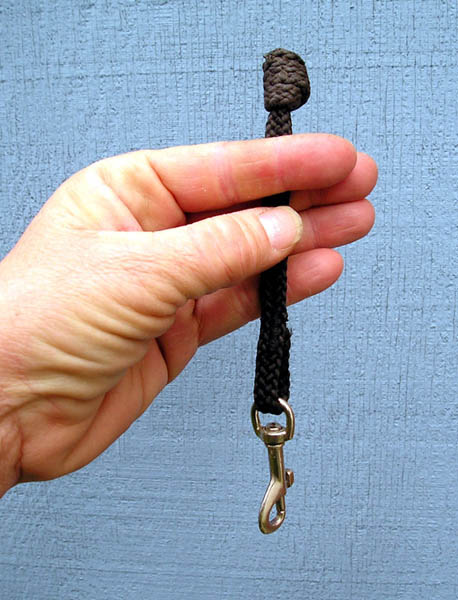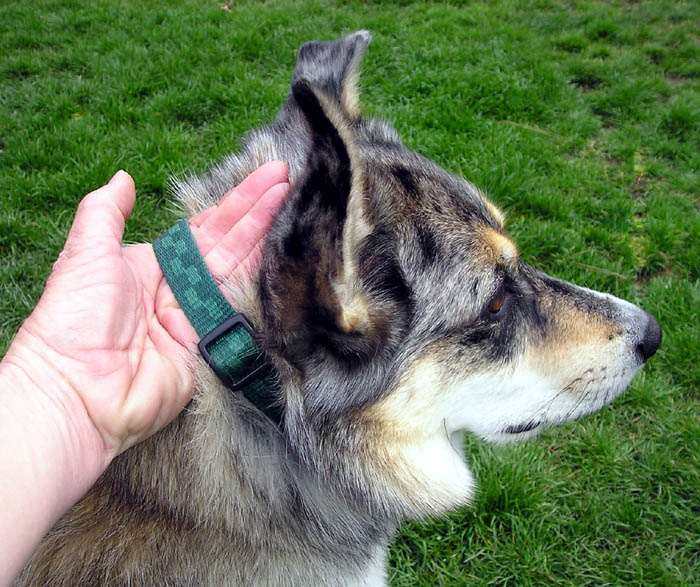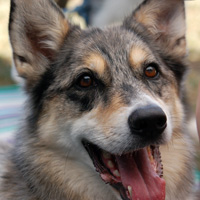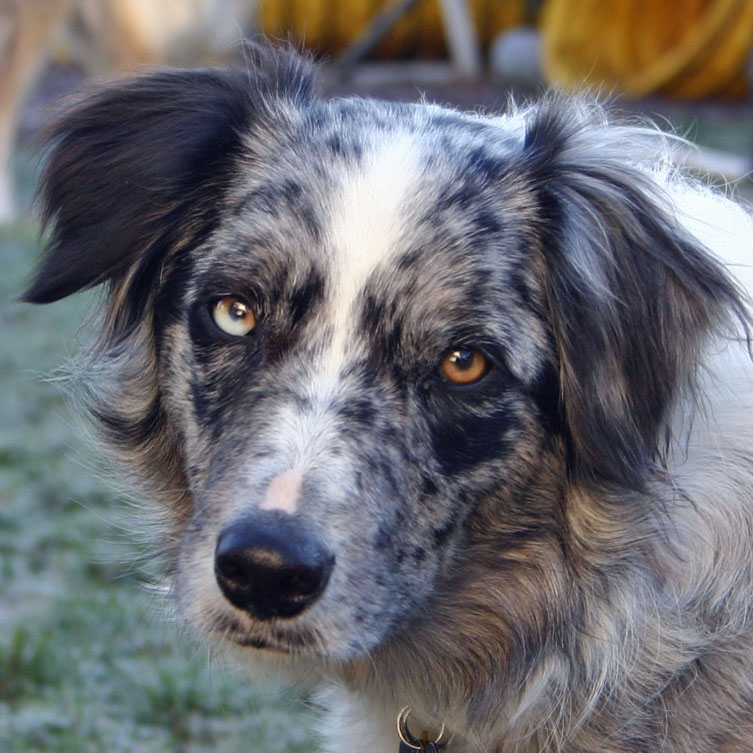Teaching a Dog to Weave
Anyone who can teach a dog to weave through her legs while she's walking can teach that dog to do weave poles--but let me be clear that it's not the same trick at all. The experience just means that the dog is accustomed to learning moving tricks and the handler is willing to work on it. Don't expect to teach weave poles (at least not the really fun, exciting, driving kind) by luring a dog through with a goodie.
Equipment needed:
|
 |
| Short tab lead. |
Disclaimer: Note that I also spent time off and on over the past several months just practicing driving between 2 poles from different angles and distances, first just throwing a toy ahead of the dog after she went through, then gradually moving the toy toss to a spot next to the second pole so that she was already starting to turn right after going through the poles. I don't know how much that helped on having drive during the rest of our training, but I do expect it to help as she becomes more independent and I start reinforcing the entry.
Here's how I taught Tika (who has very nice weaves--won't ever be a 60-pole Challenge winner but she'll be up there in the fast crowd every time) and Boost: Hand-in-the-collar.
 |
| The grip. |
The Grip
Snug the collar up around the dog's ears. Hold your hand palm up, fingers forward. Standing next to the dog, slip your hand up under the collar. This gives you control over the dog's head movement because your grip pulls the collar up towards the front of the head, allowing you to turn the dog's head left and right.
Getting Started
I started with 4 weave poles (take off the rest of the poles) the first day or two just to get me and the dog used to each other and the motion. (3 is just a single turn and, IMHO, doesn't convey the right-left or left-right weaving motion.) Walking next to the dog, guide her through the weaves, turning her head just enough left and right to get her around each pole.
It might help right at the beginning to use the favorite toy as a lure so that the dog learns to focus ahead instead of on what you're doing next to her. If you want to do this, practice first without the dog. Goal is to keep the toy at least one weave pole ahead of the dog, in the line of the poles (not out to the side), just dragging it around each pole barely enough to get the dog watching it move from side to side and drive forward towards it. I did this with Boost just a few times at the beginning. Some people use it all the way through, but my theory is that (a) the dog is learning the process WITH THE TOY THERE and taking it away changes the picture, and (b) I want the dog to be aware of as little external info as possible, just the weaves in front of her. (Hence I also want to get myself and my hand out of the picture ASAP, too.)
If the dog is pushing ahead with excitement, as Boost and Tika both did during training, the hard part is in getting their head turned and slightly pushed enough to go around the next pole as she drives forward.
Keeping Dog Motivated
Don't make the dog move backwards to get a pole. If you mess up and she gets way past one pole, just cheerfully swing her out of the poles, around you, and race back to the beginning with hand in the collar, making excited noises (this isn't a punishment--you screwed up), and start over again.
If you mess up more than 3 times (maybe only 2x if it's a dog who turns off easily), just break it off, do something else that the dog knows well (e.g., a trick), reward and play play play and keep her excited and happy. Take a deep breath, compose yourself, try again.
Every time you make it through those poles, reward immediately with the toy ahead of the poles and play play play and verbally enthuse.
Repetition
Then go back and do it with the dog on your OTHER side! (If you used your left hand the first time, use your right hand the next time.)
Work both directions on both sides of the poles EVERY time. (That is, with dog on your left, go up, reward, come back down the same side of the poles with dog on your right. Then move yourself to the other side of the poles, go up with dog on your right, reward, come back down the same side with dog on your left.)
Move the poles every day. I moved them every day to a different orientation or location in the yard. I want the only constant thing in the picture to be the poles themselves, not the landscaping to the left or the right.
Next Step
As soon as you and the dog are used to the idea, move to 6 poles (I think this is really the minimum to understand the repetitious movement). Some people think you should start with 12 from the very beginning--same argument about wanting to have a consistent environment because 6 poles *is* different from 12. But I doubt my own energy, enthusiasm, and accuracy over that many poles and that many repetitions with my hand in her collar, and I want to be rewarding as fast as possible with small but meaningful successes--there are just so many more chances for YOU to mess up with 12 poles (remember at this point that it's never the dog's fault, never ever, don't even THINK about making negative sounds or actions!).
As soon as the dog is showing the slightest signs of understanding the idea of moving in and out of poles, switch to a tab lead to let the dog provide the head turning; your goal is to hold the dog back just enough to be sure she's making the turns and give a little pressure in the right direction as needed.
Note: If you find that you're dragging the dog through rather than letting her propel herself and you holding back and guiding from behind, go back to the hand in the collar and get a lot more fun and excitement into the process and reward like crazy each time you get through the poles.
You might need to go back to hand in the collar off and on as a reminder; I gradually did more and more tab work and less and less collar work; it wasn't a complete and abrupt switch.
My other theory is that you don't ever want to reward your dog for skipping poles. If you mess up and she manages to blast past a pole, swing her around outside the poles in a circle around your body, still holding the tab lead, fast and happy and excited --don't reward, but there's no punishment involved here--and start over. Same routine as before. Remember this all the way through your training.
More Independence
The dog will start showing signs of being able to do it on her own. (We're talking a week or 2 down the line, dozens and dozens of repetitions later.) Try relaxing the pressure on the tab lead gradually to give her space to succeed on her own.This just takes time. I have trouble being patient, but patience is what it takes.
And then--breakthrough!--she'll do a whole series of 6 on her own! Reward like crazy, jump around, make a total fuss.
When she's doing 6 correctly 60-80% of the time on her own (that's 6 to 8 out of 10 times), add poles 2 at a time as fast as you possibly can. Add 2; as soon as she can do all 8 successfully 60-80% of the time, add 2 more. When doing 10 successfully most of the time, go to 12. Boost went from 6 to 12 in two sessions. It should be about that fast.
Now--on to true independence; at the moment I'm still running right exactly alongside her, can't move forward or hang back, not standing up completely straight, but all of that is going to change as quickly as I can change it, gradually moving further away from her, gradually moving ahead of her, gradually falling behind her, and on and on. And then there's reinforcing correct weave entries! There's still a long way to go to perfect weaves, but the hard part (for you) is done.
Final disclaimer: OK, I've taught Boost to weave using this method. Tika was only portions of this whole theory. I have no students to test this on. It's an accumulation of my experience in training my dogs to do many things, thousands of hours of class time with several talented instructors, many long seminars with many other talented instructors, lots of reading, lots of discussions, lots of observations of other students and their dogs. So there ya go. Complete list of labels






0 Comments:
Post a Comment
Links to this post:
Create a Link
<< Home